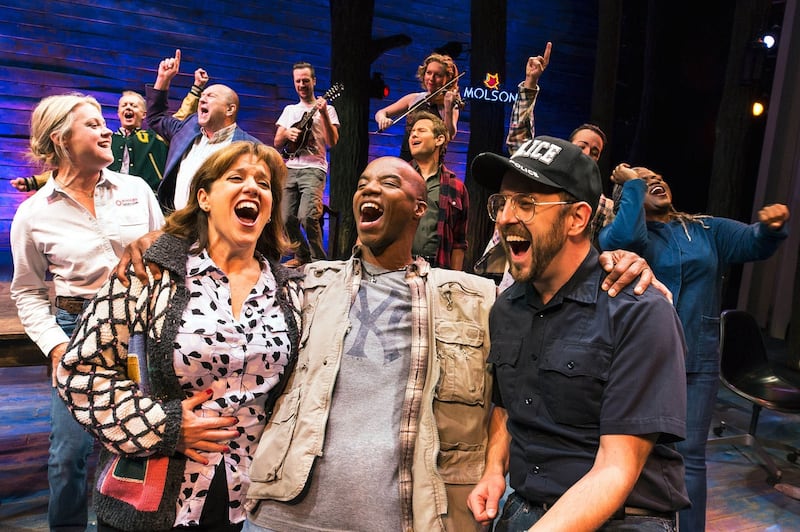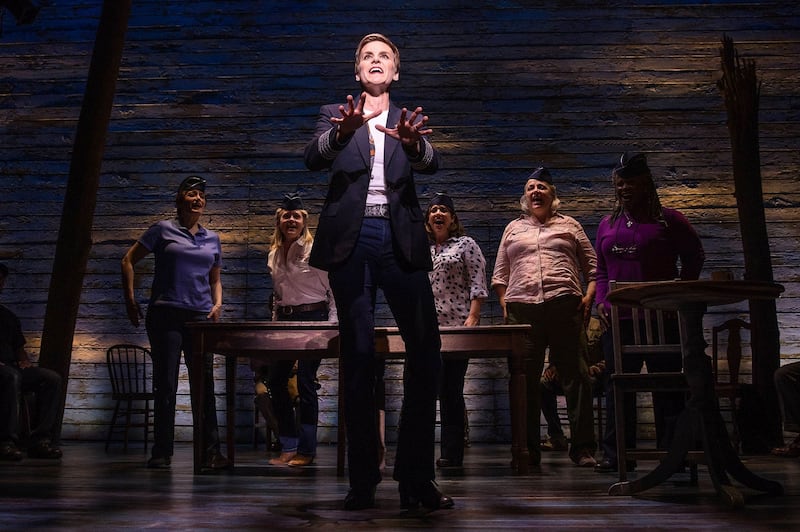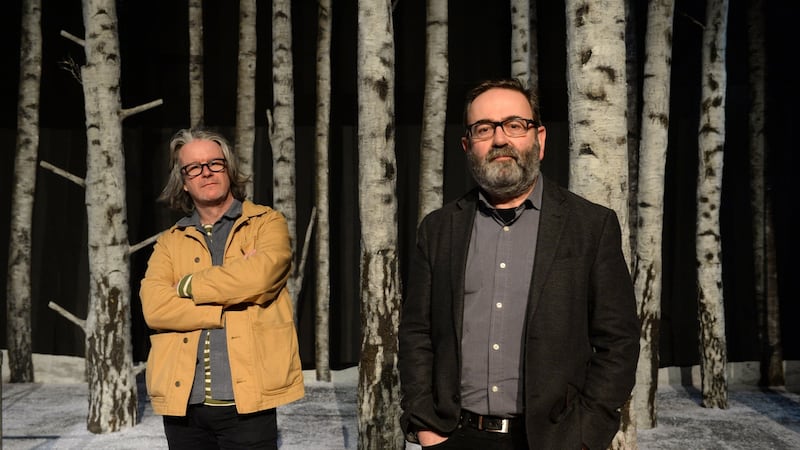Here we are, come from away, east of London in the middle of nowhere, really. This was once a cotton mill by the Lee canal, and is now a complex of buildings housing film crews and rehearsal spaces. Up on a third floor in a large, soundproofed space, is a stage-sized platform with a revolving circle in the centre, and several busy desks facing it. There is a lot of action, a cacophony of voices warming up, chairs being precisely positioned in spaces marked by tape, musicians tuning, actors tapping their hard shoes rhythmically. The blood is up.
There is a sense of excitement, of something special about to happen. The first full run through of the European premiere of Come From Away is about to start, and director Christopher Ashley welcomes the handful of outsiders - the "first guests in the room". We're standing in for 492 people who'll be seeing it on the Abbey stage in days, he tells us. It's a little cocoon up here; and how very appropriate for a show set in the little cocoon of Gander in Newfoundland, during those limbo days post-9/11, as the world paused in shock.
It’s a cracking yarn, a 9/11 side-story that offers hope for humanity in the face of pain and hatred. In the immediate aftermath of the twin towers hit, planes were grounded over US airspace. Thirty-eight flights ended up in Gander, once a busy refuelling transatlantic stop, now a small, remote town. Nearly 7,000 passengers – confused, scared, uninformed, grubby – landed without warning in Gander, nearly doubling its population. These people had come from away, from different parts of the world, and their hosts organised beds in their school and gym and homes, cooked enormous quantities of food, sourced clothes, lent a shoulder – and shared their tradition of cod-kissing (long story).

Ten years later, two writers Irene Sankoff and David Hein (book, music and lyrics) joined a reunion in Gander and soaked up stories of the 7,000 whose lives were paused while on their way somewhere else, and of the locals who unexpectedly bedded and fed the marooned. Somehow they distilled this into a multi-charactered musical drama that has become a slow-burn phenomenon, a Broadway hit alongside other productions: touring the US, playing Toronto, planned for Melbourne next year, and this show, the European premiere about to open in Dublin as an Abbey co-production.
Welcome to the Rock, they sing, setting the Newfoundland scene, and it immediately pulls you in. A dozen performers each plays multiple characters – mayor, school principal, reporter, union organiser, and myriad passengers. The pace belts ahead, without pause of leaving the stage. At a ripping pace, using just a few chairs, we have the town’s tensions, the passengers’ worries, and the story unfolds.
It’s stirring and moving and very funny and warm and highly skilled. There’s an Irish flavour to the music, and even some dancing, reflecting Newfoundland’s heritage.
Come From Away was first performed in 2015 by La Jolla Playhouse, San Diego; before playing around the US, building a buzz.
When they visited the 9/11 museum in New York, producer Randy Adams tells me as we get the lift for the runthrough, they discovered a 9/12 section, all about afterwards. "So ours was the 9/12 musical."
It opened on Broadway the following year. Along the way, performing the show for families and survivors of the Pentagon crash was significant, he says, as was presenting it at the ice-rink in Gander. The slow build was a blessing for a show that wasn’t by an established musical name, with an ensemble rather than a star, and whose title was cryptic.
Since, it has picked up a Tony award for Best Direction of a Musical, plus a display cupboard’s worth of others, from Outer Critics Circle to Gypsy Rose Lee awards.

Actor Rachel Tucker – from Belfast, and working in musical theatre in London for 15 years – couldn't get a ticket to see the show on Broadway. "There were tickets for $375. So I couldn't get a ticket." When she did see it, she thought: Wow, they never leave the stage. Then: "It was like an out-of-body experience. I was crying so hard I had snot bubbles and was laughing at the same time." David Shannon laughs and says: that's going to end up as the headline. He works between London and Dublin; the two Irish cast members in an intense company that is interdependent and "like a family", they say.
They chat about how, ironically, it was harder for the two Irish cast members to get Newfoundland’s hybrid accent right. Rachel: “Think American – or really, Canadian and then add the Gander, the dentalised Ds and Ts. You drop the Ts – then becomes den.” Then throw in a mix of Irish accents. David: “one minute you’re in Cavan, then Sligo, then Wexford”.
The show is simply staged, but for the performers in this fast paced, multi-charactered show, it is complex; in the lift, Helen Hobson (Diane and others) tells me three choreographers worked simultaneously with them, because so much happens at once.
This is director Christopher Ashley's fourth cast for the show. It's the same script, with tweaks for local audiences, and "largely it's the cast that brings new interpretations, angles, shapes and colours. This show is so much about an authenticity of storytelling, that the cast can really use themselves in the story. They are transforming and being 63 different characters, representing 7,000 Come From Aways. It's this huge epic story. But because they are talking directly to the audience they have to put themselves in it, and reveal their own soul. We really try to craft it and wrap the show around who those 12 are. And this cast is gorgeous."
Ashley is artistic director at La Jolla and has worked on shows based on true events before, but "I've never had all the real people in my life in this way. So. Beverly Bass [a stranded pilot, who was the first female captain for American Airlines, played here by Rachel Tucker] has seen the show 125 times. And Hannah, who is Irish American, is having a family reunion at the show in Dublin." Hannah, who was on an Aer Lingus flight returning from Ireland on 9/11, is distraught in the show waiting to hear from her firefighter son.
The cast is racially diverse - with a refreshing variety of age, size and bodytype. Shannon: “We’re comparatively an older show.” Tucker nods her head to rehearsals next door “In Cats they’re all 20 year olds. This show, the director wants you to look like you’re not fit to be on stage! He cast normal looking human beings.”
They’ve read the original interview transcripts, and marvel at the fluid relationship between reality and script. Writers Sankoff and Hein’s dialogue and lyrics come direct from the real interviews, sometimes “verbatim”; but it’s a cross-fertilisation – they notice real people have absorbed the characters’ words and use script soundbites in interviews.

Shannon: “Most of the script is words that were spoken by real people, so it’s true. It might be a combination of two different people, but every bit of it is true. Even the jokes – the punchlines are literally from these conversations.” Tucker: “They say Newfoundlanders have a fantastic sense of humour, they’re very dry, and they love telling stories, so they got a lot of goods from how they told jokes.”
Ashley agrees. “The Newfoundlanders are such good storytellers. They are so modest. For the first year they were saying: you’re making a musical about us making sandwiches? They are so smart about telling an emotional story and know just when to release with with a little joke or self-deprecating humour.
“It’s such an international story, people are from all over the world. And at this moment when American politics are so fractured and so many countries are trying to keep foreigners out, it’s such a great time to tell a story about people taking care of each other, saying – oh, you’re on my doorstep, let’s try to be generous.”
Come From Away is at the Abbey Theatre, Dublin, Dec 6- Jan 19, before transferring to Phoenix Theatre on London's West End from Jan 30. Abbeytheatre.ie
Abbey and Peacock ‘pretty much running non-stop’

The Abbey theatre currently has what co-director Neil Murray describes as a "mixed economy" – while the national theatre produces "as much work as it has ever made" in-house, it is also involved in various models of co-production with other Irish companies. The result is, as Murray says "the Abbey and Peacock are pretty much running non-stop, simultaneously, which was not the case for a number of years".
But there has been some disquiet in theatre circles about the heavily subsidised (€7m Arts Council funding this year, half of the theatre budget) national theatre's involvement in remounting Come From Away, a successful Broadway show prior to its West End run.
Those concerned won't criticise the Abbey openly; as one who works regularly at the theatre says, "it would be misconstrued as sour grapes, and no one want to antagonise or stick the boot in". The criticism is that Come From Away's performers, director, writers, designers, crew are not based in Ireland, so Irish theatre workers are not involved the Abbey co-produced show. Others suggest this commercial show is more suited to the Bord Gáis theatre or for a festival.
Even with little Irish involvement in the co-production, some assumed it would generate a financial surplus to invest in future Abbey productions. Murray says “We didn’t do it as a money spinner,” but chose it on its own merits. “I’m hopeful it will at worst be cost neutral, and it potentially could make us money.”
The script, music, staging and design are the same as other Come From Away productions, and this cast is rehearsing in London. Some musicians are Irish and two of 12 actors are London-based Irish (the multi-ethnic casting, "which we don't normally see on the Abbey stage" is very welcome, says Murray). The Abbey involvement includes stage management through the Dublin run and Abbey crew for the Dublin get-in. Murray won't discuss the Abbey's financial investment ("a small contribution to the overall costs"), but it includes performers' salaries in Dublin. "Once the show gets past a certain point, if it's very successful, that contribution will start to reduce, and when it transfers to London, the Abbey will receive a weekly fee from the show based on a sliding scale."
If Come From Away runs for a year on the West End, combined with Irish box office, "it'll probably end up not costing the Abbey anything". And "with a good following wind", if it runs for two years on the West End, "we would definitely recoup our initial costs and maybe make something on top". But "we didn't do it to make profit in the first place. If the show does as well as it's done elsewhere, it will bring a small income stream into the Abbey."
While the concerns are valid, Murray makes a compelling case for the co-production.
The approach from New York producers Sue Frost and Randy Adams of Junkyard Dog Productions was out of the blue. They were looking for a partner, not a receiving house. They visited the Abbey, liked what they saw (Jimmy’s Hall, and a very warm audience response). Abbey directors Murray and Graham McLaren got involved because “we wanted something that was a really different offer, a show we could not afford to make on our own”. Junkyard “are really good people, they get our needs, and are gracious”.
"The fundamental thing for me is that the show has to be right. I think people will have a fantastic experience, and a moving one. Graham and I looked really hard at the model of Come From Away to make sure it was right for us."
Murray references a conversation with Oskar Eustis, director of the Public Theatre in New York, "the doyenne of not-for-profit theatre", which has an eclectic programme, making challenging new work and also often associated with commercial transfers ("they made Hamilton, the daddy of them all"). "Oskar said, if people raise question marks about the public's engagement with what could be seen as commercial work, I ask myself two questions: 1. Is the work ethically and aesthetically right for my theatre – is it good enough, is the message right? 2. If the show makes money, will that go back into the public's grass roots activities? If the answer to both questions is yes, I do it. He said, I'm really clear about it." For Murray, "It clarified it for me. That journey felt like the right one for us."
“It’s a great story, regardless. But if there hadn’t been an Irish connection [with Newfoundland] we wouldn’t have done it. It needed to have some roots here; that longstanding relationship binds the story.”
Also, “time and place”: the timing was right – both for Christmas and “it feels like this is the right time to bring this message into the Abbey. I’m really thrilled Irish audiences will get to see the show in an environment that will be really extraordinary, and in a way that perhaps wouldn’t be affordable in a major commercial house.”
As we speak, he says, Britain’s National Theatre is about to premiere Hadestown, an American show in London, before Broadway. Such co-productions “occasionally, with the right piece”, he says, are part of the model of most European national theatres.
Top independent producer Anne Clarke, far from feeling her role is usurped, says "the Abbey as it operates now has been transformative and empowering for [her company] Landmark. Obviously it's a different model to before, but it involves many more opportunities." She talks about how Asking for It wouldn't have happened at that level without Abbey co-production, and Ballyturk wouldn't have gone to New York.
“The Abbey is programming two theatres for the entire year, and balancing the budget. So co-productions are part of their mix. Three years ago the Peacock was dark 52 weeks a year and it wasn’t a national scandal.
“It’s really easy to forget that a few years ago the Abbey did five or six shows a year, with five or six casts and teams. The Peacock was closed. People have short memories. The number of artists, given opportunities is exponentially higher.”
















